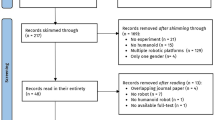You have full access to this open access chapter, Download conference paper PDF
Similar content being viewed by others
Correction to: Chapter “The Influence of Body Proportions on Perceived Gender of Robots in Latin America” in: A. D. Cheok and D. Levy (Eds.): Love and Sex with Robots, LNCS 10715, https://doi.org/10.1007/978-3-319-76369-9_12
The results section of the chapter was not correct. This has been now corrected.
Page 163:
Their mean age was 29 years (SD = 9.80)
should be
Their mean age was 29.04 years (SD = 9.79).
Page 163:
Internal consistencies (Cronbach’s α) were 0.79 for agency; 0.92 for communion; 0.72 for benevolent sexism and 0.79 for hostile sexism.
should be
Internal consistencies (Cronbach’s α) were for each stimulus: .83, .72, .83, .74, .77, .71 for agency; .90, .93, .89, .94, .94, .93 for communion. α was .72 for benevolent sexism and .79 for hostile sexism.
Page 164:
CHR and WHR are confirmed to be independent from each other (G2(2) = 0.2, p = .9).
should be
CHR and WHR are confirmed to be independent from each other (G2(2) = 0.2, p = .905).
Page 164:
and in C1 (T(56) = −3.20; p = .002). In case of C1, this is a case of mismatch with the use of pronouns.
should be
and in C1 (t(55) = −3.11; p = .003). In case of C1, this is a case of mismatch with the use of pronouns.
Page 165:
From Fig. 3 it is possible to notice that male ratings are higher for B1 and B2 and female higher for C1 and C2. Performing additional t-tests confirmed that stimuli with a high CHR correspond to higher male traits (in case of B1 and C1: T(56) = −5.04; p < .001).
should be
From Fig. 3 it is possible to notice that male ratings are higher for B1 and B2 and female higher for C1 and C2. Performing additional t-tests confirmed that stimuli with a high CHR correspond to higher male traits (in case of B1 and C1: t(55) = −4.93; p < .001).
Page 165:
The degree of attribution of female communion traits was negatively correlated both with familiarity with robots (r(56) = −.27; p = .045) and with familiarity with product design (r(56)= −.30; p = .023). Nothing significant was found between familiarity with robots and agency (r(56)= −.02; p = .9), and familiarity with product design and agency (r(56)= −.08; p = .5).
should be
The degree of attribution of female communion traits was negatively correlated both with familiarity with robots (r(54) = −.27; p = .047) and with familiarity with product design (r(55)= −.30; p = .024). Nothing significant was found between familiarity with robots and agency (r(54)= −.003; p = .979), and familiarity with product design and agency (r(55)= .08; p = .552).
Page 165:
Moreover, benevolent sexism was positively correlated with the attribution of communion-related traits to robots (r(55) = 0.48; p < .001) but not with agency-related traits (r(55) = 0.20; p = .14). Neither the correlations between communion and hostile sexism (r(55) = 0.25; p = .06) and agency and hostile sexism (r(55) = 0.23; p = .08) turned out statistically significant.
should be
Moreover, benevolent sexism was positively correlated with the attribution of communion-related traits to robots (r(54) = .48; p < .001) and with agency-related traits (r(54) = .33; p = .013). Neither the correlations between communion and hostile sexism (r(54) = .23; p = .085) and agency and hostile sexism (r(54) = .25; p = .062) turned out statistically significant.
Author information
Authors and Affiliations
Corresponding author
Editor information
Editors and Affiliations
Rights and permissions
Copyright information
© 2019 Springer International Publishing AG, part of Springer Nature
About this paper
Cite this paper
Trovato, G., Lucho, C., Eyssel, F., Bernotat, J. (2019). Correction to: The Influence of Body Proportions on Perceived Gender of Robots in Latin America. In: Cheok, A., Levy, D. (eds) Love and Sex with Robots. LSR 2017. Lecture Notes in Computer Science(), vol 10715. Springer, Cham. https://doi.org/10.1007/978-3-319-76369-9_13
Download citation
DOI: https://doi.org/10.1007/978-3-319-76369-9_13
Published:
Publisher Name: Springer, Cham
Print ISBN: 978-3-319-76368-2
Online ISBN: 978-3-319-76369-9
eBook Packages: Computer ScienceComputer Science (R0)




